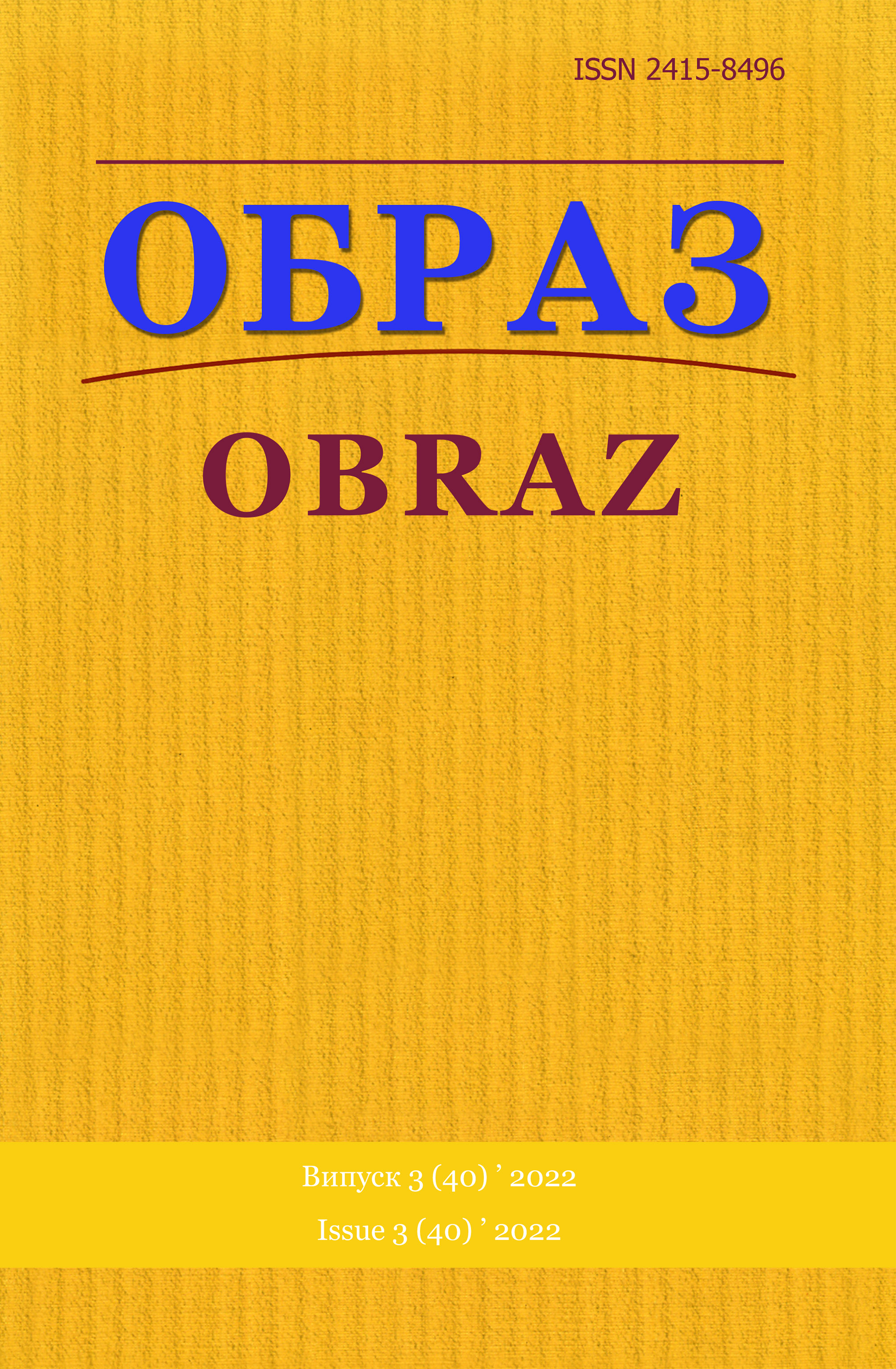Abstract
Introduction. The mythological structure of the series is determined by structural, semantic and symbolic elements embedded in the communicative process; they represent a kind of filter
that depends on all the formal and content components of the series, as well as the cultural field in which it functions. This allows the series to be an active translator of various messages, which, in
turn, requires the active participation of the viewer in assigning contents and messages.
Relevance of research. The scientific novelty consists in the analysis of the modern TV series as a communicative phenomenon in modern media culture. Based on the analysis of various
sources, we tried to describe the structure and identify different communicative strategies of modern serials, a specific serial paradigm that allows satisfying all categories of viewers.
The research methodology: we use interdisciplinary approaches to understanding the communication potential of modern TV series: cultural-historical, communication, structural and
cultural analysis.
Results and discussion. The study of TV series allows us to understand how communicative connections are recreated in the modern socio-cultural environment, what ideological tasks they
can fulfill and how they influence the formation of identity. In the series, we can find certain revelations about the norms and dominant ideas of a specific cultural-historical discourse, which in
their date allow us to reveal the closed elements of norming, subtexts and contexts, discrimination and inclusion, dominance and subordination, which are organically woven into the structure of
the series as a product of mass culture.
Conclusions and prospects. In the article, we found out that the increase in the influence and popularity of TV series as a specific cultural form of communication is related to their ability
to be an effective sphere of communication space. The communication potential of serials is determined by the structural and content elements, which proved to be capable of structuring
the everyday life and identity of a person. The description and analysis of the structural and content elements of the series made it possible to reveal the specific communicative potential of
the modern series – to be an active translator of various messages, to form a communicative space, which, in turn, requires the active participation of the viewer in assigning contents and messages.
References
1. Bart, R. (1994), Myth today. Selected works: Semiotics. Poetics, Yzdatelskaya gruppa «Progress», «Unyvers», Moscow, 616 p., available at: https://www.booksite.ru/fulltext/bar/bart_r/1.htm.
2. Vanyushina, O. (2009), «The series as a phenomenon of mass culture», Visnyk KNTEU, no. 3, pp. 101–112, available at: http://visnik.knute.edu.ua/files/2009/03/14.pdf.
3. Voznesenska, O. (2013), «The system of value orientations of characters in modern TV series as a factor in the formation of values of children and youth», Naukovi Studiji iz Socialjnoji ta Politychnoji Psykhologhiji: Zb. statej [Scientific studies in social and political psychology: collection. articles], Milenium, Kyiv, vol. 32 (35), pp. 294–302.
4. Zagorodniuk, Y. (2015), «Sitcom as a topical form of comic in mass culture», Ghileja: Naukovyj Visnyk [Gilea: Scientific Bulletin], iss. 99, pp. 278–283, available at: http://nbuv.gov.ua/UJRN/ gileya_2015_99_69.
5. Zrazhevska, N.I. (2014), «Approaches to the analysis of enigmatic media texts», Naukovi Zapysky Instytutu Zhurnalistyky [Scientific notes of the Institute of Journalism], vol. 57, pp. 11–16, available at: http://lib.ru/CULTURE/PROPP/mor fologia.txt.
6. Kavelty, D. (1996), «The study of literary formulas», Novoe lyteraturnoe obozrenye [New Literary Review], no. 22, available at: https://bit.ly/3daysnn.
7. Pocheptsov, G. (2014), «Television series as media communication», Stop Fake, available at: https://www.stopfake.org/ru/georgij-potseptsov-o-teleserialah-kak-mediakommunikatsiyah.
8. Pocheptsov, G. (2019), «Visual «players» beat verbal ones, like a TV series - a novel», Detektor Media [Media detector], available at: https://ms.detector.media/mediaanalitika/post/23504/2019- 09-15-vyzualnye-ygroky-pobezhdayut-verbalnykh-kak-teleseryal-roman/.
9. Propp, V. (1998), Morphology of a Fairy Tale, Labyrynt, Moscow, available at: http://www.lib.ru/ CULTURE/PROPP/morfologia.txt.
10. Story, J.(2005), Theory of Culture and Mass Culture, Akta, Kharkiv, 360 p., available at: https:// b-ok.cc/book/3165044/e651ae?redirect=149950899.
11. «What are dramedy, cliffhanger, filler: 10 terms about TV series that you should know, available at: https://maximum.fm/shcho-take-dramedi-klifgenger-filer-10-terminiv-pro-seriali-yaki-vartoznati_n201063.
12. Allen, C. (1995), To be continued…soap operas around the world, London, 398 p.
13. Bignell, J. (2001), Postmodern Media Culture, Edinburg, 240 р.
14. Cawelti, John G. (1976), Adventure, Mystery, and Romance: Formula Stories as Art and Popular Culture, University of Chicago Press, Chicago, 344 р.
15. Cheu, J. (ed.). (2013), Diversity in Disney films: Critical Essays on race, ethnicity, gender, sexuality and disability, McFarland, available at : https://bit.ly/3ir1Zuv
16. Felski, R. (2011), «Suspicious minds», Poetics today, vol. 32, no. 2, available at: http:// michaelbryson.net/teaching/csun/felskisuspicion1.pdf
17. Garcφa, A.N. (ed.). (2016), Emotions in contemporary TV series, Springer, available at: https:// www.academia.edu/33343098/Emotions_in_Contemporary_TV_Series.
18. Keen, S. (2011), «Introduction: Narrative and the emotions», Poetics Today, vol. 32, no. 1, available at: https://bit.ly/3tS0Oct
19. Kellner, D. (2000), Media Culture: Cultural studies, identity and politics between the modern and postmodern, London, N.Y., 357 p.
20. Loock, K., Verevis, C. (ed.). (2012), Film remakes, adaptations and fan productions: Remake/ remodel, Palgrave Macmillan, Basingstoke, 252 p., available at: https://journals.openedition.org/ inmedia/561
21. Smoodin, E.L. (ed.). (1994), Disney discourse: Producing the magic kingdom, Psychology Press, available at: https://journals.openedition.org/inmedia/561.
22. Taylor, B. (2020), «Rebels against the Anthropocene? Ideology, Spirituality, Popular Culture, and Human Domination of the World within the Disney Empire», Journal for the Study of Religion, Nature and Culture, vol.. 13, no. 4, available at: https://journal.equinoxpub.com/JSRNC/article/ view/17676.

This work is licensed under a Creative Commons Attribution 4.0 International License.

